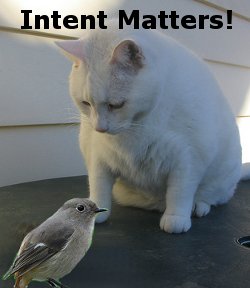
You may be thinking I am going to write about some huge blog scandal that embarrassed a CEO, relieved somebody of their U.S. Senate seat, or made somebody in Hollywood look like a complete loser in some way. Those stories are abundant, and even quite popular, but they bore me. I’ll save that for the day when I crash my head into a speeding train and decide that there is value in luring brainless zombies to read my blog.
For the time being, I still plan to write for you business brainiacs who care more about building a business than the latest juicy gossip or fad-of-the-day.
Today, I want to discuss an even far more punishing type of blog failure that comes with either having a blog without a strategy, or not having a blog at all. First, for anybody muttering some nonsense like “Pffftt … Blogs, schmogs … who needs ’em?” you may be wise to read “10 Really Good Reasons to Blog“. In any case, just hold your seat and pay attention for some eye-opening considerations.
Types of Blogs and Blog Strategies
There are obviously many different types of blogs, and each has its own strategy. I cannot list them all here, but I want to give you examples. Some of them are just for the purpose of bringing squillions of people to click on something brain-numbingly stupid to waste their time. Other blogs are designed to help brain-numbed people to believe that the Internet will give them “easy money”. We all love these blogs. I say “we all”, but the ridiculous numbers don’t lie. In fact, check this out … I brought some numbers!
Brain-Numbing (but Hilarious) Blogs
These are some very successful blogs, but many people do not even comprehend where the success is. They are ad-supported, and some sell shirts, hats, and other stuff, which is fine, but it takes a lot of visitors to make money this way. I mean a lot! If I had to guess their revenues, I would bet most of these earn their company a lot more money than your company blog. They are spending a lot more on personnel, too, because that is often what it takes when a strategy requires huge traffic numbers.
icanhascheezburger.com: As the home of “lolcats”, the “I Can Has Cheezburger” blog appeals to people’s love of cats, and it brings people back frequently to look for the latest funny stuff cats are doing. It is working like a charm, too. The website is ranked in the top 1,000 websites visited by Internet users in USA and in the top 3,000 in the world, according to alexa.com. The Internet collectively says “we love this stuff!”
failblog.org: “Fail Blog” fascinates readers around the world with the astonishing stupidity of people. General “run-of-the-mill” stupid people doing stupid things is a sure bet to help otherwise productive people to melt brain cells and burn hours. Fail Blog is ranked very similar to icanhascheezburger.com, and is a part of the same extensive network that reports more than 20 million website visitors per month. Cheezburger Network takes about 65 people and a lot of money to manage it well. If you don’t have that kind of manpower, creativity, and dollars, this strategy probably won’t work for you.
peopleofwalmart.com: How could this one possibly fail? “People of Wal Mart” lures people in by the nose and helps them stick it high in the air. Even a brief look at the People of Wal Mart website will show you how much better you are than those horrid looking creatures cruising the aisles of Wal Mart stores. This website is roughly in the top 2,000 most visited websites in USA and in the top 10,000 in the world. Yes, we really love to make fun of people … especially when we can see how clearly “better” we are than them.

Socially Numbing Blogs
People love to read about social media. Although there is no obvious correlation between wasting time reading everything you can about the latest iPhone apps or social media corporate buyouts, these blogs are taking it all the way to the bank! Don’t take this all wrong, they have some reasonably good information sometimes, but between the overt brand bias and repetitive drivel, I feel compelled to announce these with a bit of a snide slant. In any case, they are about as popular as bacon.

mashable.com: This social media giant is astonishing! Mashable is a time-sucking cult favorite of glassy-eyed people hoping to be on top of a social media wave. It commonly ranks in the top 200 most popular websites in the world. Why? Perhaps it is because the whole world wants to become a social media expert by reciting what they read at Mashable. As long as this is the case, it will be wildly popular. If you want to know which technology company is doing what, or which iPhone app is better, it is fine. Click on an advertisement while you are there … they love that!
techcrunch.com: Tech Crunch is kind of like Mashable with a bad toupee. They have a couple reasonably decent writers with good intentions of reporting on technology issues, but let’s be serious … will that make you an expert? I guess it is great if you want to know which online game company was just purchased for a billion dollars, or the new fads in cell phones. Will you really do more business if you read everything Tech Crunch reports? The answer is “probably not”, but if you want to sound impressive to a non-paying audience, you may want to retweet everything you see there, and expand upon it in your own blog. Just don’t plan on getting rich that way.
Socially Engaging Blogs
It is a very popular myth that “engagement” in a community is a key to online success. It has its high points, but it also has some pretty big downsides. Note that I did call it a myth.
Being engaging and engaged can provide amazing benefits, but without an appropriate strategy, engagement still fails miserably from a business standpoint. If you are just engaging an audience because you think it will bring success, think again. You can have a squillion buddies, but if it has no relevance to your business strategy, you can spend a lot of time being unproductive with those buddies. You may not like it, but that is the harsh truth. I can be your friend, and I may even help you to spread the word about those awesome knitting needles you are trying so hard to sell, but I only have so many friends interested in knitting.

I wrote about some engaging bloggers recently, and they provide great examples of reader engagement. These bloggers are hard-workers with a lot of talent, and they can show you some fine points. Here is the list of “9 Bloggers Who Teach the Value of a Strong Blog Community“. These blogs generally don’t need huge numbers of readers, and are often very targeted toward specific topics that attract specific readers. This is commonly a much more readily achievable type of blog strategy for individual bloggers or small companies.
Building relationships and engaging with others is very important in building an online success, but it is still not a magic success potion. Sorry pals … but somebody had to say it.
Commonalities of Failed Blogs
Back to the story line, I want to submit that there is not just one single thing that will make a blog successful. The biggest missing piece I see among unsuccessful blogs is a strategy. Popularity is great, but it takes a lot of work, and usually a lot of money to make a blog popular enough to succeed on traffic volume alone. Carefully curated content geared toward a popular topic is a way to become popular, but that can still fail if there is not a targeted and well-defined expected outcome.

I see it all the time that the first reaction of companies who don’t see great results from their blog is to give up. Instead of making the needed strategic adjustments, they assume it was a bad idea that just doesn’t work.
A truth that most people are slow to accept is that if the blog isn’t paying the bills, it is not the Internet public’s fault … it is their own. In the case of most blogs, and statistically, probably even yours, the results are a bit less than hoped for. So, do you give up, or do you shift gears?
It is easy to see common factors of successful blogs. Some of the blogs I mentioned have a sizable staff that work hard every day, others have a small staff of one. They are diverse, but each of them have some things in common. They each have a strategy, and they each understand that nothing comes from nothing. Doing “nothing” is popular, too, but that is probably not a good strategy for you.
A Competitive Strategy
A strategy that is extremely popular and competitive is to rub a genie’s lamp, keep your fingers crossed, knock on wood, pray like a nun in a whorehouse, and hope that your blog will somehow become a huge success without hard work. That is just dandy, but it is a pretty weak attempt that usually yields even weaker results.
So, in case you may wonder, what is my strategy? After all, it would be silly to write about it if I didn’t have one. I cannot tell you the whole thing, but I can at least give you enough to help get some thoughts flowing. Maybe you can pick up some ideas about your own strategy if I share some key points of my own.

Is it the ads? No, they barely pay for my coffee and cigarette bill. Is it the cozy notion of having a squillion friends who will send flowers when I die of starvation from blogging instead of working for a living? Well, not exactly, but you are certainly welcome to send donations to The Murnahan Memorial Fund, c/o Widow Murnahan, PO Box 4426, Topeka, KS, 66604. Widow Peggy thanks you in advance.
I take a mix of each of the above approaches, plus some other special considerations. I discovered, long ago, that when I write things that people find useful mixed with amusing (or at least not dreadfully boring), and I make good connections with people, they share it with others in their social circles. That helps me to achieve my objectives of tens of thousands of incoming website links to my work, high website traffic, and ability to rank extremely well in search engines for darn near anything I choose to target. This also helps me to establish credibility as an authority in my industry and provide irrefutable proof that I am very good at my job. This is a pretty sound strategy, overall, and it can apply to many other types of industries.
Each of these things help more people know to my work. Some of them will realize that this Murnahan character has uncommon talent and is quite good at creative marketing. A tiny few of my readers will realize they could do even better with additional professional help, and they contact me to develop their marketing strategy, and to execute the plan. That is how I get paid. That is my success. You didn’t actually think I do all of this because I’m bored, did you? Most bloggers don’t work so hard just because they have nothing to do.
The Worst Blog Failure in Summary
In concert with a previous article about reasons to blog, I also explained reasons blogs fail. I may be the only person that this amuses, but if you search Google for either of the terms I just linked to (reasons to blog and reasons blogs fail), you will find my work quite readily. That would never have happened if I didn’t write something about it, implement my strategy, and execute it better than others.
Doing nothing, or doing something without conviction is an easy path to giving up. The same holds true for anything from talking your first love out of their pants to talking your next customer out of their money.
How is your strategy coming along?
Photo Credits:
Cat in a big box by CelloPics via Flickr
Shaved Cat by Jamie (ajmexico) via Flickr
Cat on bird house by Josh (joshme17) via Flickr
Roslyn_cat by Joshin Yamada (ocean yamaha) via Flickr
Fail Cat by Tara Hunt (miss_rogue) via Flickr
Doomed by Robin Corps (robad0b) via Flickr
Podcast: Play in new window | Download






